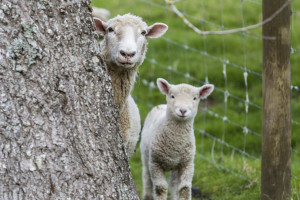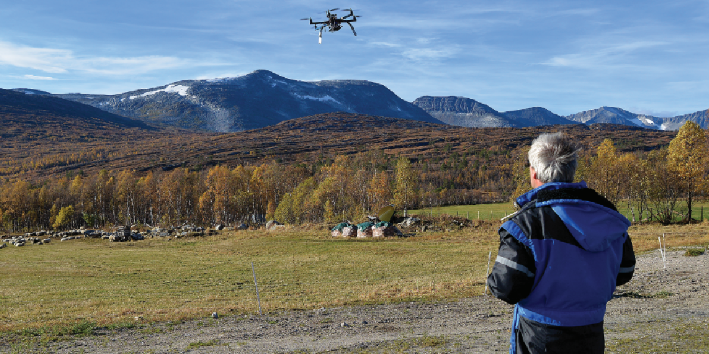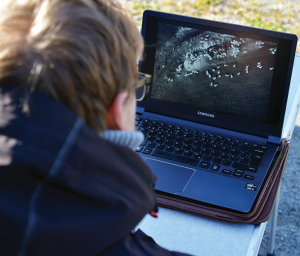Drones help find lost sheep
Looking for sheep can be done a lot more effectively than today. A drone may be a farmer’s next tool in finding their lost lambs.
DRONES: Every year, sheep farmers and their assistants spend tens of hours looking for sheep that have been separated from their flock. Sometimes this search is successful, but sometimes a farmer just has to admit that their sheep is lost.
What if all of these lost sheep could be found?
This is the idea behind Svein-Olaf Hvasshovd’s work. This professor at the Department of Computer and Information Science has participated in the hunt for lost sheep before, and experienced just how difficult it can be to find the woolly creatures. During last year’s sheep-finding operation, they discovered that several sheep had managed to pull off their bells, making them almost impossible to find. After this, he put on the proverbial thinking cap to find a better solution for finding lost sheep.

Sheep sometimes travel far out of reach of both cell and satellite coverage. So the experts have to be creative in finding alternative solutions. Photo: Thinkstock
Heat-seeking cameras
How do you find sheep that can’t communicate in any way? After considering the options,
Hvasshovd came up with the idea of using drones to look for lost sheep.
But a normal camera drone wouldn’t work. You need more advanced equipment.
“We decided to put an infrared camera on the drone,” says Hvasshovd.
Infrared cameras ‘see’ temperatures, so they can be used to look for living creatures in a geographic area.
A few weeks ago, Hvasshovd, together with colleagues from the control systems group at NTNU completed a test in Oppdal. In their backpack was a drone equipped with a thermal imaging camera. The group had a drone pilot, and someone to scan the data sent from the camera on its flight.
Promising results
The conditions weren’t exactly ideal during the test in October. It was in the middle of a fairly warm day. Hvasshovd worried that the difference in temperature wouldn’t be enough for the drone’s camera to pick up.
However, to the team’s surprise, the camera could clearly see the difference between the sheep and the ground.
In a snowy landscape, identifying sheep with a thermal imaging camera would be even easier, because of the greater difference in temperature between the animal and the snow shows up well in infrared. On the other hand, the difference between white wool and white snow is much more difficult for our eyes to see. For this reason, Hvasshovd is optimistic about using drones for finding sheep when it is colder.
“The sheep was very visible. There was a clear difference between the hill and the sheep.”
Testing with a plane
During the Oppdal test, the experts used a so-called quadcopter, which is a small, battery driven drone with four rotors. This type of drone is, however not the best solution, as sheep often spread out over a large area. Small quadcopters like the one used in the test can only fly for about 20-30 minutes.
The solution? An autonomous plane.
“Our test has shown that this is a technique worth investigating further. But we need more flying time. So we’re going to try a similar test with an autonomous plane.”
Sheep and technology hand-in-hand
Hvasshovd has other ideas about using technology on sheep:
- Having a system of radio base stations that pair with collars on sheep to keep in contact. This idea will be tested thoroughly next summer, but Hvasshovd has already had promising results. An early test last year showed that coverage even in rough terrain is good. The idea is to use signal strength to determine a sheep’s location.
- Sensor technology to help monitor sheep health. One type of sensor can be attached to a sheep’s ear, while another can be swallowed. These can provide information about heartbeat and body temperature.
- Another idea is to use electrical signals to help keep the sheep within range of the farm, setting up a sort of virtual fence that makes an annoying sound when a sheep gets to close, or a mild shock if a sheep crosses it. The problem is that sheep don’t necessarily respond reliably to this.
The next craft they are testing has a wingspan of almost two metres, a gas engine, and a flying time of two to five hours.
“If you can search for several hours without breaks, you can cover a much larger area in less time. Our next tests, this spring, will be to see if the images that the camera takes are clear enough, if it is possible to distinguish the sheep from the background.”
No revolution
Agriculture hasn’t seen any huge technological revolutions in this area, partly due to a lack of funding.
“Self-driving harvesters have become more and more common. Dairy cows have collars and processors that provide information about an animal and what it eats. But the big revolution hasn’t come yet,” Hvasshovd said.
This makes it difficult for him to predict how a sheep farmer’s life will look in ten years. But he gives it a try anyway:
“It may not be dramatically changed, but we’ll see some new tools and technologies. The really big changeover will be the day farmers no longer have to go searching for lost sheep.”
Hope to commercialize the idea
Even though their work is still in the early stages, the idea of commercializing sheep-finding drones is already a possibility, according to Hvasshovd. He thinks it is unlikely that any existing companies will come up with something like this.
“Our first job is to see if it works,” Hvasshovd says. “If it does, it only makes sense to bring it to market. Sheep farmers are open to this sort of technology. They are very interested in finding methods to reduce the amount of work and time it takes to find lost sheep.”
The average farmer, however, is not an experienced drone pilot.
“A normal farmer may have trouble operating this type of technology. Appropriate permits may also be an issue. But we imagine that it could be in a sheep farmer’s interest to get the correct permits and training,” he says
However, he thinks that it is more likely that breeders will collectively use this kind of technology for finding lost sheep.
And who knows, maybe one day we will be using drones to herd sheep, like in the video clip below?






